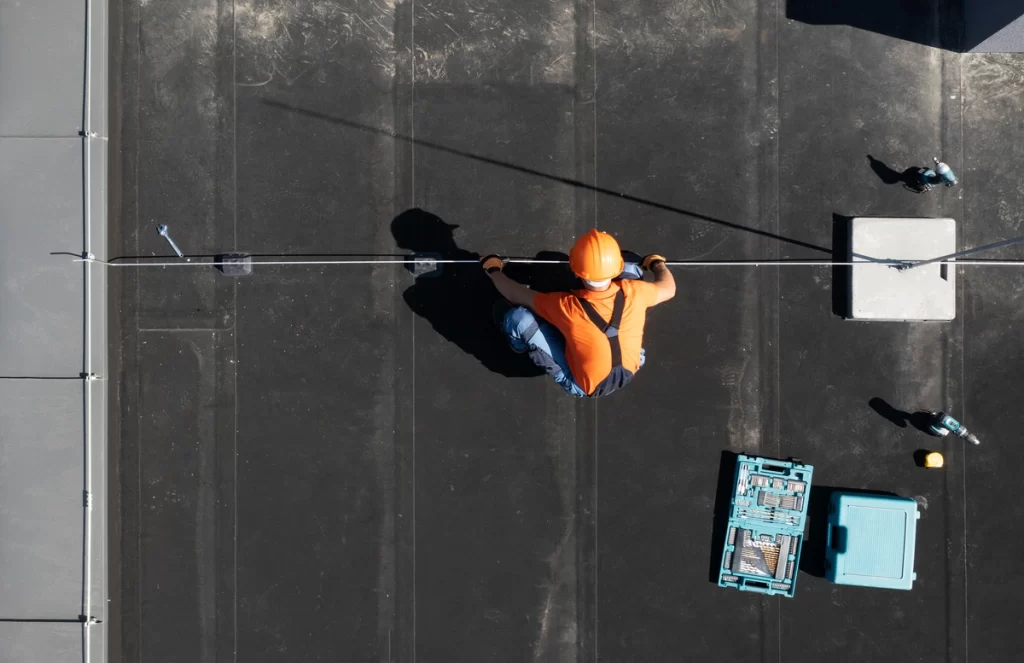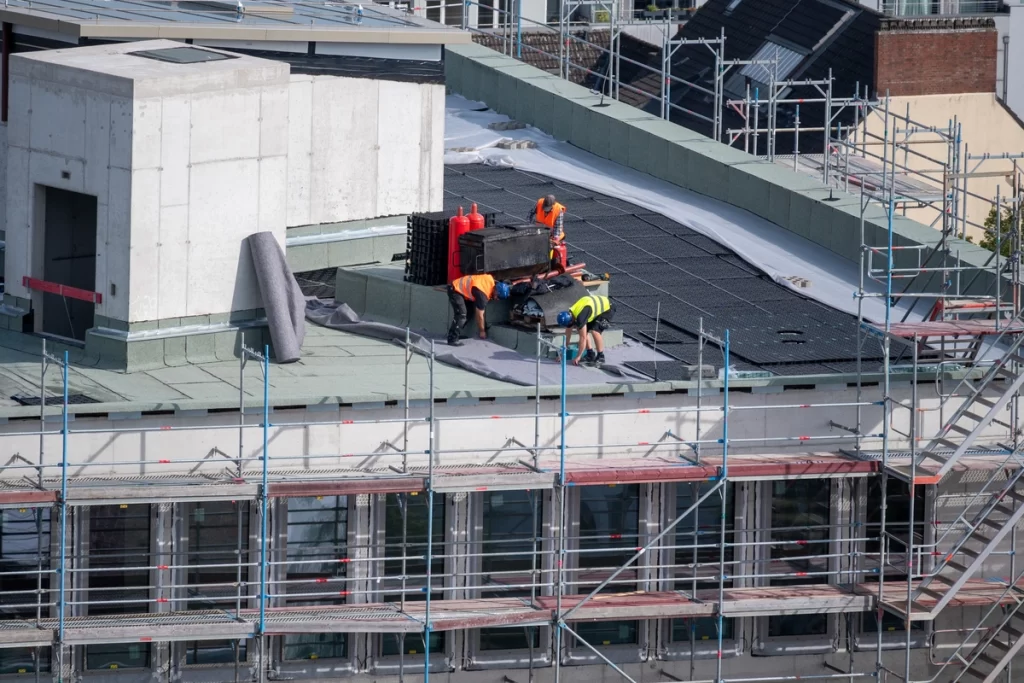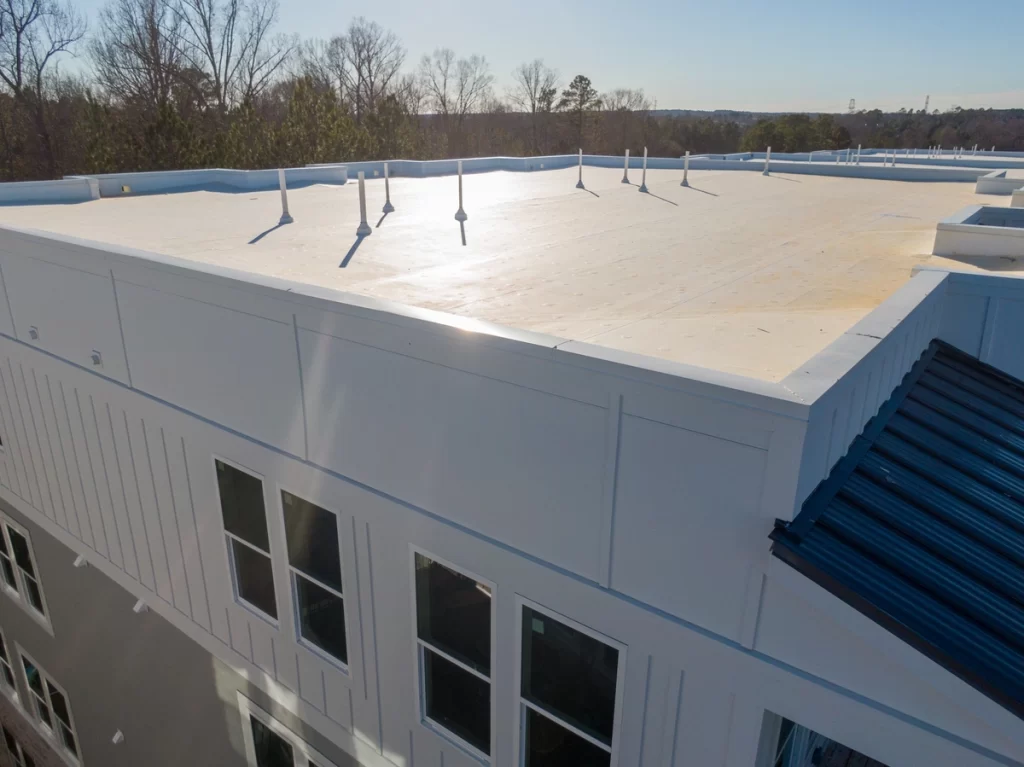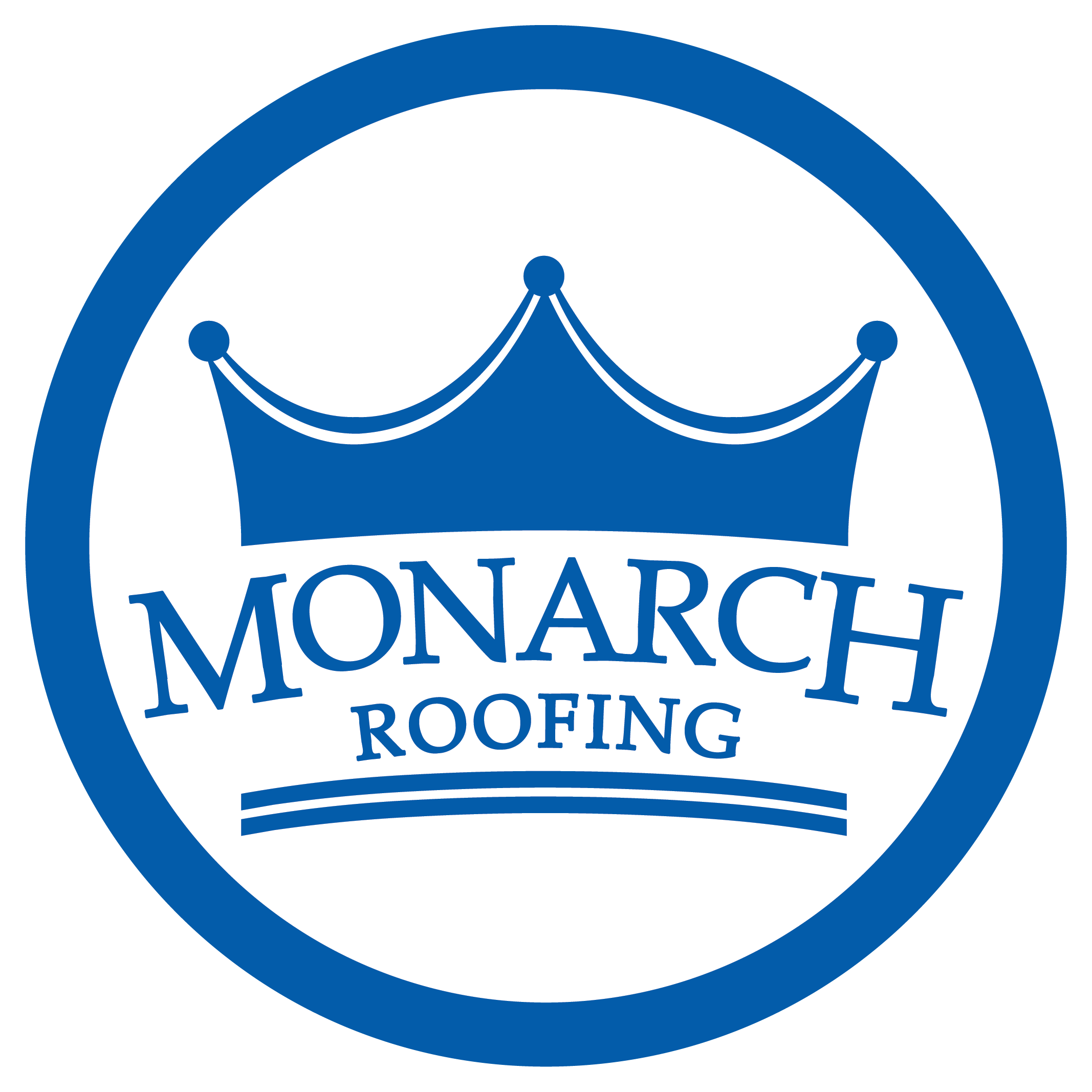Investing in a new commercial roof is a significant decision that comes with substantial financial implications. Whether you own an:
- Office building
- A retail center
- An industrial facility
A well-installed roof is essential for protecting your property and ensuring the safety of its occupants. This guide aims to provide commercial property owners with everything they need to know about commercial roof installation, from materials and costs to timelines and best practices.
Why a Quality Roof Matters
A well-installed and maintained roof offers numerous benefits:
- Protects the Building: A quality roof safeguards the structure against weather elements, preventing water damage, mold, and structural weaknesses.
- Enhances Energy Efficiency: Modern commercial roofing materials can improve insulation, reducing heating and cooling costs.
- Increases Property Value: A durable, aesthetically pleasing roof can increase your property’s market value.
- Ensures Safety: Proper installation reduces the risk of leaks, collapses, and other hazards, safeguarding the well-being of occupants and visitors.
6 Types of Commercial Roofing Materials

Before embarking on a commercial roof installation project, it’s essential to understand the different roofing materials available:
1. Built-Up Roofing (BUR)
BUR consists of multiple layers of bitumen and reinforcing fabrics. Commonly known as “tar and gravel” roofs, they offer excellent waterproofing.
Benefits:
- Proven durability and longevity
- Excellent UV protection
- Low maintenance requirements
Considerations:
- Heavier than other options
- Longer installation times
2. Modified Bitumen Roofing
This material is an evolution of BUR, featuring enhanced performance due to polymer modification of asphalt.
Benefits:
- High tensile strength
- Resistant to extreme weather conditions
- Easy to install and repair
Considerations:
- Requires professional installation to ensure proper application
3. Ethylene Propylene Diene Monomer (EPDM)
EPDM is a synthetic rubber membrane known for its durability and versatility.
Benefits:
- Long lifespan (up to 30 years)
- Easy to install and repair
- Cost-effective
Considerations:
- Vulnerable to punctures and tears
- Can shrink over time if not correctly installed
4. Thermoplastic Olefin (TPO)
TPO membranes are made from a blend of polypropylene and ethylene-propylene rubber, offering a balance of durability and cost-effectiveness.
Benefits:
- Resistant to UV radiation and ozone
- Energy-efficient due to reflective surface
- Easy to install
Considerations:
- Requires experienced installers for proper seam welding
- Durability can vary between manufacturers
5. Metal Roofing
Metal roofing systems use panels or sheets made from steel, aluminum, or other metals.
Benefits:
- Extremely durable and long-lasting
- Fire-resistant and environmentally friendly
- Low maintenance
Considerations:
- Higher initial cost
- Requires specialized installation to prevent leaks
6. Green Roofing
Green roofs incorporate vegetation, creating a living layer that offers environmental and aesthetic benefits.
Benefits:
- Reduces urban heat island effect
- Improves air quality and stormwater management
- Enhances building aesthetics
Considerations:
- Higher initial cost and maintenance requirements
- Structural considerations due to added weight
Key Steps in Commercial Roof Installation
Wondering what to expect with the installation of your commercial roof? Here’s what will go down:
Initial Consultation and Assessment
The process begins with an initial consultation with a professional roofing contractor. During this phase, the contractor will assess the current roof condition, discuss your requirements, and provide recommendations based on factors such as your budget, climate, and building type.
Material Selection
Based on the assessment, the contractor will help you choose the most suitable roofing material. This decision will take into account factors like durability, energy efficiency, cost, and aesthetic preferences.
Cost Estimation and Budgeting
A detailed cost estimate will be provided, outlining the expenses associated with materials, labor, permits, and other related costs. It’s crucial to set a realistic budget and factor in potential contingencies.
Permits and Approvals
Before installation can commence, necessary permits and approvals must be obtained from local authorities. Your contractor will typically handle this process, ensuring compliance with building codes and regulations.
Site Preparation and Safety Measures
Preparing the site involves clearing debris, setting up safety barriers, and ensuring proper access for equipment and materials. Safety measures, such as fall protection and proper scaffolding, are essential to protect workers and occupants.
Old Roof Removal (if applicable)
If your building has an existing roof, it will need to be removed. This process involves stripping away old materials, addressing underlying issues, and disposing of debris properly.
Installation of Roofing System
The actual installation of the new roofing system begins. The steps involved will vary depending on the chosen material but generally include:
- Laying down insulation layers
- Installing the roofing membrane or panels
- Sealing seams and joints
- Adding protective coatings or surfacing
Quality Assurance and Inspection
Once the installation is complete, a thorough inspection is conducted to ensure the roof meets quality and safety standards. Any issues identified during this phase are addressed promptly.
Final Cleanup and Site Restoration
After the inspection, the site is cleaned up, and any equipment or waste materials are removed. The property is restored to its original condition, and the new roof is ready for use.
Ongoing Maintenance and Warranty
To maximize the lifespan of your new roof, regular maintenance is essential. Establish a maintenance schedule that includes inspections, cleaning, and minor repairs. Additionally, ensure you understand the terms of the warranty provided by the roofing contractor.
Dos and Don’ts of Commercial Roof Installation

Keep these dos and don’ts in mind before starting the installation process.
👍Dos
- Do Choose Experienced Professionals: Ensure your roofing contractor has a solid reputation and experience with commercial installations. Check references and read reviews to make an informed decision.
- Do Conduct Regular Inspections: Schedule periodic inspections before and after installation to identify potential issues early and ensure the roofing system is functioning properly.
- Do Adhere to Local Building Codes: Familiarise yourself with local regulations and ensure that all work complies with building codes to avoid legal complications.
- Do Invest in Quality Materials: Opt for durable and reliable roofing materials that fit your budget while providing long-term value and performance.
- Do Plan for Proper Drainage: Ensure that your roof installation includes sufficient drainage systems to avoid water pooling, which can lead to leaks and structural damage.
👎Don’ts
- Don’t Skimp on Safety: Never compromise on safety measures during installation. Ensuring a safe working environment is crucial for the protection of workers and the integrity of the installation.
- Don’t Ignore Weather Conditions: Avoid scheduling installations during adverse weather conditions, as this can affect the quality of work and lead to complications.
- Don’t Rush the Process: Take the time needed for each phase of the installation. Rushing can result in mistakes that may compromise the roof’s longevity.
- Don’t Overlook Warranty Details: Ensure you fully understand the warranty offered by your contractor and what is covered. Keep documentation for future reference.
- Don’t Neglect Maintenance: After installation, continue with regular maintenance. Neglecting maintenance can shorten the lifespan of your roof and lead to costly repairs.
Costs Involved in Commercial Roof Installation
The cost of commercial roof installation can vary widely based on several factors:
- Material Costs: Different roofing materials come with different price tags. For example, metal roofing is typically more expensive than EPDM or TPO membranes.
- Labor Costs: Labor costs will depend on the complexity of the installation, the size of the roof, and the expertise required. More intricate installations, such as green roofs, may incur higher labor costs.
- Additional Costs: Other expenses to consider include permits, inspections, and potential repairs to the underlying structure. It’s essential to budget for these additional costs to avoid unexpected financial strain.
- Long-Term Savings: While the initial investment may be significant, it’s essential to consider the long-term savings associated with a high-quality roof. Improved energy efficiency, reduced maintenance costs, and increased property value can all contribute to a positive return on investment.
Choosing the Right Roofing Contractor
Selecting the right roofing contractor is crucial to the success of your project. Consider the following factors when making your choice:
- Experience and Expertise: Look for contractors with extensive experience in commercial roofing installations. Check their portfolio and request references to gauge their expertise.
- Licensing and Insurance: Ensure the contractor holds the necessary licenses and insurance coverage to protect against accidents and liabilities.
- Reputation and Reviews: Research online reviews and testimonials to get a sense of the contractor’s reputation. Positive feedback from previous clients is a good indicator of reliable service.
- Warranty and Guarantees: Choose a contractor who offers comprehensive warranties and guarantees on their work. This provides peace of mind and ensures accountability for any issues that may arise.
- Communication and Transparency: Effective communication is critical throughout the project. Choose a contractor who is transparent about costs, timelines, and potential challenges.
Commercial Roof Installation Pros

Investing in a new commercial roof is a significant decision that requires careful consideration and planning.
Remember, a well-installed roof not only protects your property but also enhances its value and efficiency. If you’re ready to take the next step in securing your commercial property, contact Monarch Roofing today to schedule a consultation.





